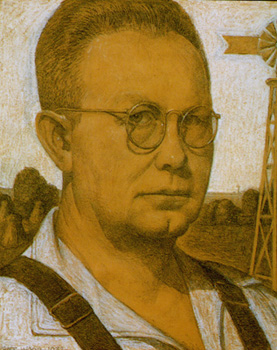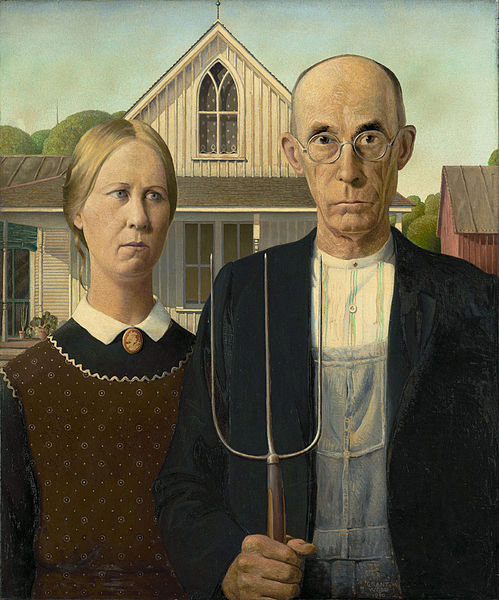| Grant Wood | |
|---|---|
 |
|
| Born | Grant DeVolson Wood Feb. 13, 1891 Anamosa, Iowa |
| Died | Feb. 12, 1942 (at age 50) Iowa City, Iowa |
| Nationality | American |
| Education | School of the Art Institute of Chicago |
| Movement | Regionalism |
| Field | Painting |
| Works | View Complete Works |
Born February 13, 1891 to Hattie Weaver and Francis Maryville Wood, Grant DeVolson Wood grew up on a farm in a small town in Iowa. The small town atmosphere and farmland landscaping would become a significant factor of his future success as an artist. His brightly created oil paintings of bountiful farms and of the local people would contrast the view of hopelessness during the Great Depression during the period in which they were painted. Grant Wood tried to capture the inspirational and unique essence of the Midwest for a uniquely American style of painting, based on various influences from European and German artists, but with a style of his own. His style, which became prominent in the 1930’s, is said to bridge a gap between abstract and academic realist art. His “American Gothic” painting has become an American icon.
Grant Wood promoted the Regionalism movement in art, shunning the city with its technology and urban lifestyle, in order to focus on the scenic, rural life of the Midwest, and America. Regionalism was at its height from 1930-1935, with other artists such as Thomas Hart from Missouri, and John Steuart Curry from Kansas. The scenic paintings with humble subjects, and the anti-modernist style, depicted everyday life. In a statement made when presenting his final painting, Wood said, “I had in mind something which I hope to convey to America – the picture of a country rich with peace; a nation infinitely worth the sacrifices necessary to its preservation.”
How Grant Wood’s Life Created His Art
 Grant was one of four children (Frank, Jack and Nan) who lived on the farm until their father died unexpectedly. Grant was ten years old. His mother had to sell their farm, and they moved to Cedar Rapids, Iowa, a much bigger town, with very different urban lifestyles. Grant showed an interest in drawing. When he was fourteen, he won third place in a national coloring contest with a crayon drawing of an oak tree. The roots of art were planted. Grant befriended Marvin Cone in high school, and the two became the school’s staff artists. After graduation from high school in 1810, Grant took a train to Minnesota to attend the School of Design and Handicraft, spending two summers there.
Grant was one of four children (Frank, Jack and Nan) who lived on the farm until their father died unexpectedly. Grant was ten years old. His mother had to sell their farm, and they moved to Cedar Rapids, Iowa, a much bigger town, with very different urban lifestyles. Grant showed an interest in drawing. When he was fourteen, he won third place in a national coloring contest with a crayon drawing of an oak tree. The roots of art were planted. Grant befriended Marvin Cone in high school, and the two became the school’s staff artists. After graduation from high school in 1810, Grant took a train to Minnesota to attend the School of Design and Handicraft, spending two summers there.
Returning to Cedar Rapids, he then became an illustrator, with Paul C. Hanson as photographer the following summer. Late that summer in 2011, he passed the Iowa Teachers Exam with only a provisional one year license, due to poor grades in school. From 1911-1912, He taught at Rosedale School, consisting of one room, three miles away. That spring he worked at Kalo Silversmiths in Chicago, and began taking night art classes at the Chicago Art Institute. In 1916, he opened the “Wolund,” a silversmith shop with his friend Christoper Hago in Park Ridge. The shop did not last long, and Grant returned to Cedar Rapids upon hearing that his mother was to be evicted from the farm.
In 1917, Grant enlisted in the Army in order to provide income for the family, and traveled to Washington to do camouflage work, remaining there until the war was over. In 1919, he was hired as an art teacher at Jackson Junior High School. In 1920, Grant and Marvin Cone, his high school friend, traveled to France for the summer. Grant resumed his teaching of art at McKinley High School back in Iowa and then ventured back to France to study at Paris’ Academie Julien, taking a leave of absence from teaching. He returned to teach at McKinley High, also working as an interior decorator on the side.
David Turner, a Cedar Rapids mortician, came into the picture by offering Grant and his mother a garage/stable/carriage-house to live in rent-free, because Grant had created various paintings for him. Grant turned the hayloft into his studio, and named the carriage-house “5 Turner Alley”, because it did not have a legal address of its own. Grant resigned from teaching in 1925 in order to focus on his painting, and in 1926, returned to France, to hold an Expo in Paris exhibiting his works at the Gallerie Carmine, since his works had received no attention in the United States.
In 1927, his works acquired German influence. Grant was commissioned to do a large stained glass window, and he went to Germany to see how it was to be completed correctly. There he was influenced by Gothic overtones, satire, and caricatures. It took him 2 years to complete the window, and he was paid $6,000. When he arrived back in Iowa in 1929, on a trip to Eldon, he saw a small house in a field with a unique Gothic window, which impressed him. This one window became the background for his most notable painting American Gothic.
The 1930’s were a professional building stage for Grant Wood, with Stone City in progress, and Arnold (Pyle) Comes of Age winning the sweepstakes at the Iowa State Fair. American Gothic is then displayed at the Chicago Art Institute Annual Exhibition, and the Institution bought his painting for $300. Grant was finally being recognized for his new and creative work. In 1932, Grant takes part in the Stone City Art Colony, organized to help artists survive the Great Depression, and in 1934, Grant organizes the Public Works of Art Project (PWAP) in Iowa, offering recognition to, and contracted jobs for artists in the area.
From 1934 to 1941, Grant married for a brief time and became an Associate Professor of Fine Arts at the University of Iowa. He lectured throughout the country on regionalism, supervised the Corn Room mural project using the subtractive technique of painting, mentored students, continued painting, and became a prominent figure of the University’s cultural community. Exactly one day before Grant’s 51st birthday, he died of pancreatic cancer. Grant Wood’s various paintings now belong to and are displayed at the Figge Art Museum, in Davenport, Iowa.
Grant Wood’s history really did shape his paintings and later recognition. He strived to create truly unique American art. His four trips to Europe allowed him to study impressionism, and post-impressionism, and the work of Jan Van Eyck, a Flemish artist, influenced him to present the clarity of this new technique and to use in his own works. Grant Wood’s style has been compared to American Folk art, with his simplified forms, and to Norman Rockwell also, but Grant Wood admired and learned from others in order to create truly American art.
Grant Wood’s Style, Pattern, And Perspective
- Brilliantly colored, yet static forms
- Utilizes Oil Glazes
- Ornamental patterning
- Patterned surfaces
- Utilizes Pointillism
- Utilizes elements of abstraction
- Uses a simplified, schematic theme
- Intense color interactions
- Utilizes optical treatises
- Charcoal sketches
- Utilizes Lithography medium
- Used the Subtractive technique, or wiping away paint to create a painting
- Paintings reveal Gothic overtones, satire, and caricature